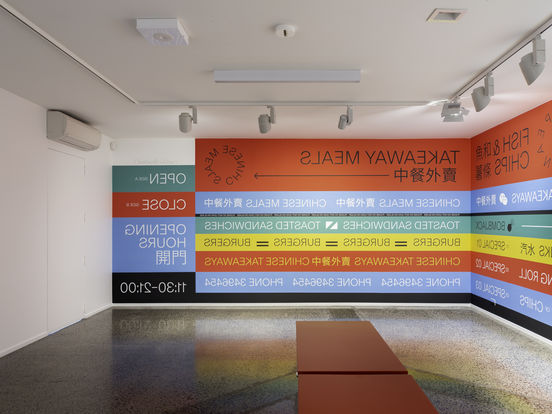-
Author
K. Emma Ng -
Date
23 Nov 2021
Essay
Toro Whakaara: Lindsay Yee
I’ll admit it – sometimes the food at Asian fusion restaurants tastes pretty good. I used to waitress at one. For my shift meal I’d order dumplings that I liked because they reminded me of shui mai (though they were double the price). But what pisses me off – and it’s endemic here in Wellington – is how busy these places are. I resent waiting for a table when I could slide right into an Asian-run joint around the corner. Slap on a zombi-llenial veneer – a neon sign, exposed concrete, some moody lighting, and maybe a Tretchikoff painting – and the wait for a table becomes longer than yum cha start-to-finish on a Sunday. What sort of shadow do these hyper-ambient restaurants cast on Asian Asian places? By contrast, could you say that fish and chip shops and bare-bones Cantonese cafés constitute a kind of hostile architecture?
Well, it depends on where you’re standing. If you close your eyes, can you imagine the Asian Asian place that you know best? Can you picture the wipe-down Formica, menu patched over with A4 additions, unforgiving lighting, utilitarian typefaces, vinyl seats, dog-eared magazines, and layers and layers of signage? Can you smell the lingering wok hei or the liquid gold of the fryer? Does it feel like home?
In Toro Whakaara, Lindsay Yee shares the view from behind the counter, looking out from the back of the fish and chip shop. For some, it will be a familiar outlook. For others, who have never entered a takeaway shop through an alleyway or back door, it’ll be a shift in perspective. I’m not a shop kid like Lindsay, but fish and chips do run in my mum’s side of the family. I know what the back rooms of these shops look like, and the way they come to be a second home. If your parents run one, it’s where you’ll spend a lot of your time – doing homework, watching TV, eating dinner, and helping out. My mum and her five siblings would sometimes even sleep at the shop, when thick fog made the late-night drive from Dunedin to their North Taieri farm too dangerous.
Lindsay’s distinction between back and front, and his focus on the liminal space in between, is a nuance carefully observed by someone who’s lived it. The architecture of the fish and chip shop is not hostile – there’s little innate defence or resistance, aggression or conflict. Instead the shop is more like a buffer or contact zone, as described by Mary Louise Pratt in the 1990s: a social space where ‘members of subordinated or marginalised groups’ might ‘select and invent from materials transmitted by a dominant metropolitan culture’. Really, these shops were the original Asian fusion restaurants – their menus a rendezvous between the deep fryer and the gas-fired wok. Fish and chip shops have always been their own little border towns, where cultural influences mingle, jumble and sit side-by-side. Likely introduced to Britain by Jewish refugees and vitalised by Friday-fish Catholics, fish and chips have long been a gateway for migrants, who – since at least the 1950s – have swelled the menus with their own Indonesian, Greek or Cantonese offerings.
The back of the shop is more than just a physical position, it shapes the way you experience the world passing by out front. When protestors marched through Dunedin during the 1981 Springbok tour, my mum’s family locked up the shop and watched demonstrators clash with police from the upstairs windows. Life in the diaspora often stratifies into public and private, with assimilation occurring at a different pace in each of these spaces. At home, or at the back of the shop, cultural customs are held more tightly. Out front, English is spoken, relationships with regulars grow, children go to school, to university; become doctors, lawyers, accountants, architects, designers, artists.
When she first formulated the idea of the contact zone, Mary Louise Pratt was (as a professor of language and literature) writing about an Andean manuscript from 1613. Here, the takeaway shop is our twenty-first-century text – a space where migrants become Pratt’s agents of adaption and invention. For the families that run these shops, it’s where a future is drafted. As for the rest of us, we can appreciate that the architecture is authored with blind focus for what people really want: crispy fish and chips – and a spring roll – wrapped together in newsprint to be carried steaming into the night.
--
Lindsay Yee (余杰峰) is a graphic designer based in Tāmaki Makaurau Auckland. Born and raised in Ōtautahi Christchurch, he studied visual communications at CPIT and moved to Tāmaki in 2010. His parents originate from Oamaru and Guangzhou (廣州). His family previously worked in fish and chips, with extended family still operating in the industry. Yee works as a designer in studios and agencies in Tāmaki, with work in brand identity design. With his own practice, Yee focuses on arts and culture, specifically exploring representation of Chinese people in Aotearoa. He has worked with organisations within the fine arts, theatre, film, music and design.
K. Emma Ng is a curator and writer living in Te Whanganui-a-Tara Wellington. Working within the fields of art and design, she has developed exhibitions and other programmes for galleries and museums across the region. Her writing has featured on The Pantograph Punch, ArtAsiaPacific, Hyperallergic and The Spinoff, and she published Old Asian, New Asian with Bridget Williams Books in 2017.
--
This text is republished from Toro Whakaara: Responses to our built environment, a publication produced by Objectspace to accompany an exhibition of the same name. The publication is edited by Tessa Forde, and copy-edited by Anna Hodge.

Lindsay Yee, Chinese Takeaways, 2021, in Toro Whakaara: Responses to our built environment at Objectspace